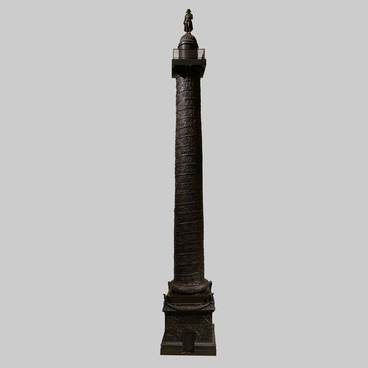Mikhail Kutuzov was a great commander, statesman and skilled diplomat, whose merits to the Motherland were, figuratively speaking, engraved in golden letters in the history of the Russian Empire. According to his wife, Ekaterina Bibikova, Mikhail Illarionovich was a big lover of tea parties. Presented to your attention is a samovar belonging to Kutuzov. Its ‘barrel’ shape is more suitable for home furnishings, but it could accompany the outstanding commander in field conditions as well.
The samovar is made of copper and brass. The body (main vessel) has a peculiar barrel-shaped form. It is turned horizontally and mounted on a decorative quadrangular pallet with angular legs. The samovar is outfitted with massive metal handles welded to the body, which are fully functional.
The walls are engraved with ring-shaped grooves and dents imitating the rims of a wooden barrel. The burner with a convex body and a flange that extends upward is decorated with elongated slots. The grill is decorated with a flag-like ornament carved in metal. The tap is casted and has a complex shape; it is decorated with an elaborate pattern and outfitted with a rotating wooden thumbscrew. Two similar thumbscrews are installed on the cover.
The first documented references to the advent of tea in Russia date back to the 17th century. During the reign of Ekaterina the Great, the Russian nobility began to consume tea in huge quantities. The traditions of tea drinking in those days were ubiquitous among the intelligentsia and the nobility. Against this background, at the beginning of the 19th century samovar became an integral attribute of the Russian tea parties, adorning the homes of privileged classes.
Barrel-shaped samovars appeared in Russia at the turn of the 18th and 19th century. They were especially popular during the first third of the 19th century. They were made manually by craftsmen in the areas traditionally associated with the processing of non-ferrous metals: in the Urals, in Tula, and in Moscow. The most popular materials for samovars are copper and its alloys (brass and yellow pewter).
In 1912, the samovar was exhibited in the halls of the Imperial Russian History Museum at the anniversary exhibition, which was to become the Museum of the Patriotic War of 1812. The samovar was handed over to the museum as a memorial item with old numbers of the exhibition inventory (No. 3567 from VIII-247 and No. 175) and the entry ‘belonged to Kutuzov’. The authenticity of the exhibit and its historical value are confirmed by the publication in the Catalog of the Exhibition of 1812 under No.175, Moscow, 1913.
The samovar is made of copper and brass. The body (main vessel) has a peculiar barrel-shaped form. It is turned horizontally and mounted on a decorative quadrangular pallet with angular legs. The samovar is outfitted with massive metal handles welded to the body, which are fully functional.
The walls are engraved with ring-shaped grooves and dents imitating the rims of a wooden barrel. The burner with a convex body and a flange that extends upward is decorated with elongated slots. The grill is decorated with a flag-like ornament carved in metal. The tap is casted and has a complex shape; it is decorated with an elaborate pattern and outfitted with a rotating wooden thumbscrew. Two similar thumbscrews are installed on the cover.
The first documented references to the advent of tea in Russia date back to the 17th century. During the reign of Ekaterina the Great, the Russian nobility began to consume tea in huge quantities. The traditions of tea drinking in those days were ubiquitous among the intelligentsia and the nobility. Against this background, at the beginning of the 19th century samovar became an integral attribute of the Russian tea parties, adorning the homes of privileged classes.
Barrel-shaped samovars appeared in Russia at the turn of the 18th and 19th century. They were especially popular during the first third of the 19th century. They were made manually by craftsmen in the areas traditionally associated with the processing of non-ferrous metals: in the Urals, in Tula, and in Moscow. The most popular materials for samovars are copper and its alloys (brass and yellow pewter).
In 1912, the samovar was exhibited in the halls of the Imperial Russian History Museum at the anniversary exhibition, which was to become the Museum of the Patriotic War of 1812. The samovar was handed over to the museum as a memorial item with old numbers of the exhibition inventory (No. 3567 from VIII-247 and No. 175) and the entry ‘belonged to Kutuzov’. The authenticity of the exhibit and its historical value are confirmed by the publication in the Catalog of the Exhibition of 1812 under No.175, Moscow, 1913.



